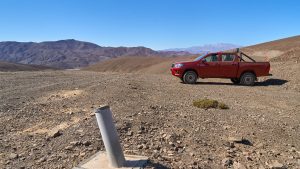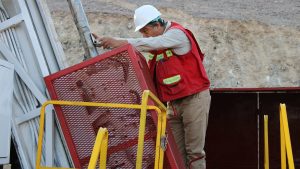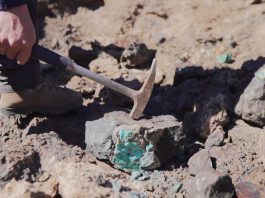Micro-junior Golden Arrow Resources is actively exploring a prime location for copper in Chile which adjoins one of the largest developers in the Atacama region and has copper mines all around.
Like a small shop in Manhattan that is surrounded by skyscrapers in all directions, one may wonder: How did this little operation land here? How could they afford the pricey address? What are they doing? Are they onto something?
Yes, it is a wonder, and yes, they are onto something. Golden Arrow Resources Corp. (GARWF.OTCQB; GRG.V) controls 100% of the exploration and exploitation concessions of the San Pietro copper-gold-cobalt-iron project, which totals 18,448 hectares. This is a very substantial project, both in terms of size and prospective mineralisation.
Golden Arrow is a bona fide micro-junior with a market value of $8m. Yet, it does belong here. The company is a team of long-term exploration specialists, involved with four major discoveries across the Andes in Argentina: two in production today by major miners; one in extended preparation; and one still expanding.
Golden Arrow’s last discovery, the Chinchillas Silver Project in northwest Argentina, was acquired by SSR Mining, and is in production. Golden Arrow was able to acquire Chinchillas at a low cost because the prior explorer found silver there but didn’t have the vision and expertise to find enough to build resources. Golden Arrow geologists made a new interpretation of the mineralisation, drilled it out, defined resources, and sold it to nearby producer SSR Mining – and the project is working for SSR as a producing mine.
Could the same strategy work among the copper giants in northern Chile?
San Pietro was first drilled by respected Sumitomo Metal Mining a decade ago. They found copper in Chile, along with gold, iron and cobalt, but a combination of their interpretations and market economics meant that they couldn’t move the project forward at the time. With a shift in their corporate focus last year, Sumitomo decided to sell off the project and, despite its size and ideal location, other major copper producers stayed away, likely believing Sumitomo’s work was the end of the line for the property.
However, like with Chinchillas, Golden Arrow’s geologists have made a new interpretation of the mineralisation at San Pietro. As small exploration specialists, they try hard, look deep and innovate.
Golden Arrow was able to acquire the entire project from Sumitomo’s shelf for just $3.5m. The company just finished initial drill testing at four of the large zones, and their reinterpretations appear correct in all four areas. The next round of drilling is planned to start late in the third quarter this year. San Pietro might well become an exciting copper, cobalt, gold, and iron exploration project.
But to appreciate the opportunity here, we first need to set the table.
Setting the table: Copper plays a major role in the green revolution
The growth factor of copper production gets more important every year. Electrification runs on copper. Electric vehicles (EVs) require significantly more copper than regular cars, on average 183 pounds per car compared to 51 pounds, according to the International Copper Association. An EV uses copper in electric motors, batteries, inverters – which convert direct current to alternating current to run the motors – and in the cables and recharging stations.
Per Benchmark Mineral Intelligence, a cleaner, greener future depends on how rapidly lithium and copper production can increase. Copper in Chile will play a vital role in this expansion.
Cobalt is also an essential part of the more expensive lithium-ion batteries that give EVs the longer range and durability needed by a high percentage of US and European drivers, according to the Cobalt Institute. The cathode of the nickel-manganese-cobalt batteries (NMC) contains 10-20% cobalt. As reported by statista.com, more than 65% of global cobalt production in 2021 and 2022 came from the Democratic Republic of the Congo (DRC).
Large mining companies are buying major copper assets
The world’s major miners know what is likely coming to the copper market, since they are direct participants and can see the future of copper supply and demand better than anyone.
In April this year, top five copper producer Glencore (GLNCY) – which produces 2.2 billion pounds per year (lbs/yr) – offered $23bn for Canada’s Teck Resources (TECK) (2023 forecast: net 767 million pounds of copper, plus zinc and coal). Teck hasn’t accepted the offer yet, but it ‘remains on the table’.
In May, BHP, the top three copper producer and the world’s largest mining company by market capitalisation, already producing 2.8 billion pounds of copper/year, acquired OZ Minerals for $6.4bn with annual production of 210,000 gold ounces and 275 million pounds of copper.
Largest gold miners buying copper
The big gold miners Newmont Corporation (NEM) and Barrick Gold (GOLD) apparently see a similar future regarding copper.
Newmont is acquiring copper and gold miner Newcrest Mining (NCMGY) for approximately $19bn. The deal is scheduled to close by the end of 2023 and will boost Newmont’s annual production to eight million gold ounces and 340 million pounds of copper. Newmont’s acquisition of Newcrest adds four gold and copper mines to its portfolio: Cadia, Telfer, Red Chris, and Wafi-Golpu.
Barrick has been much more active than Newmont in terms of acquiring copper assets. It has acquired half of northern Chile’s Zaldívar mine, as well as half of the Jabal Sayid mine in Saudi Arabia. Most recently, Barrick acquired 100% of the Lumwana mine in Zambia.
On 15 June this year, Bloomberg and Reuters reported that Barrick made an offer to acquire the top seven copper producer First Quantum Minerals (FQVLF), one that is ‘still on the table’. A no-premium deal for First Quantum, which is producing 1.7 billion pounds of copper per year, would cost approximately $16bn. If a deal does go through, the cost will most likely be higher.
Barrick also has two copper mines in pre-development which are Norte Abierto in northern Chile and the Reko Diq copper-gold project in Pakistan, two enormous resources.
Is it possible that these very large mining companies anticipate a bright future for copper assets?
How copper in Chile fits into the global market
Chile is the largest copper-producing and copper-exporting country in the world, more than doubling the production of the second largest producer and exporter, Peru, in 2021 and 2022. While southern Chile does have some production, the great majority of copper in Chile comes from the north, which holds most of its copper reserves, according to britannica.com.
With many of the largest mining companies scouring the world for major copper assets, which starts in northern Chile, there are simply not many micro-cap explorers in the thick of it, 100km north of Copiapo, one of the centres of copper, silver, gold and now, potentially cobalt production.
Here, GRG has established its flagship San Pietro project, 100% controlled, 18,500 hectares, an area equivalent to 13-1/2km by 13-1/2km.
San Pietro’s neighbours
Surrounded by large copper assets, San Pietro lies directly adjacent on the west border of Capstone Copper’s fully-permitted Santo Domingo iron oxide, copper, gold and cobalt mine development project – a more than $1bn development to expand Capstone’s already large copper production close by at their Mantoverde copper mine, with plans to add cobalt production.1
Capstone’s Mantoverde mine – approximately 18km south-west of San Pietro – is also, this year, expected to complete new capital projects costing $850m, expanding production capacity from approximately 50,000 tonnes/year to a rate of 120,000 tonnes/year of copper starting in 2024.
By adding in the Santo Domingo development plan, Capstone’s target is to reach 200,000 tonnes/year of copper, plus importantly, potentially 6,000 to 6,500 tonnes/year of cobalt, thereby becoming one of the free-world’s largest sources of cobalt.
Prior drilling at San Pietro
GRG’s project was earlier drilled by Sumitomo Metal Mining, 83 holes, more than 34,000m, which yielded some strong mineralisation, copper, iron and notably cobalt. It sat on Sumitomo’s shelf from 2012 until a year ago when Golden Arrow acquired the project.
Since that time, GRG has relogged the key drill holes, re-interpreted numerous geophysical surveys, added a 3-D IP/resistivity survey and modernised and added to the database to refine new drill targets in the search for copper in Chile.
Why GRG’s first drilling programme was so key
The recently completed Phase-1 drill programme consisted of 13 holes that totalled approximately 4,000m in four key target areas. The holes tested several new interpretations to fine-tune targeting for the subsequent drilling campaign planned in the third or fourth quarter of this year.
VP of Exploration & Development Brian McEwen stated in a recent interview: “When San Pietro was looked at in the past, metal prices were quite a bit lower, and I doubt cobalt was given a lot of consideration at that time.
“We have some very high cobalt intersections close to the surface that now are looking very attractive.”
Rincones Zone
Six of the 13 drill holes were in the central Rincones Target. This is the area where the most holes by Sumitomo had been drilled, and is anticipated to be the first area for Golden Arrow to initiate a resource delineation programme to potentially define an initial resource estimate.
Hole SP-DDH-12 was drilled into the sparsely tested central part of the Rincones target area and tested the depth extent of a newly mapped copper-bearing magnetite outcrop. Results are highlighted by:
- 64.2m @ 0.86% Cu, 0.20 g/t Au, 196 g/t Co and 25.9% Fe starting at 42.8m depth; and
- 75.0m @ 0.23% Cu, 0.03 g/t Au and 67 g/t Co starting at 243m depth, followed by a short high-grade Co-Fe interval of 3.3m @ 0.22% Cu, 0.05g/t Au, 333 g/t Co and 33.37% Fe.
Hole SP-DDH-05, drilled 300m southwest of SP-DDH-12 in the southern Rincones area, returned:
- 79.8m @ 0.29% Cu, 0.05g/t Au and 179g/t Co, including 15.3m @ 0.64% Cu, 0.10 g/t Au and 388g/t Co at 272.1m depth.
Hole SP-DDH-07 filled in a 250m gap between historic holes in the northern part of the target. This hole had a best interval of:
- 87.7m @ 0.34% Cu, 0.08 g/t Au and 238 g/t Co, starting at 38.2 m depth, with four higher grade internal intervals, such as 10.55m @ 0.83% Cu, 0.12 g/t Au and 183 g/t Co.
Similar results to Capstone’s Santo Domingo mine development next door
San Pietro is situated adjacent to the Santo Domingo mine development project owned by Capstone Copper Corp., as noted earlier. Santo Domingo hosts similar styles of iron-oxide, copper, gold and cobalt mineralisation to that observed at San Pietro in deposits with reported measured and indicated resources, inclusive of reserves, of 536,548kt averaging 0.30% Cu, 0.04g/t Au, 229ppm Co and 25.7% Fe (see Santo Domingo Project, Region III, Chile, NI 43-101 Technical Report. Prepared by Maycock et al., effective 19 February 2020, www.capstonecopper.com.)
Investors are cautioned that proximity to these deposits does not indicate that similar mineralisation will occur at San Pietro, and if mineralisation does occur, that it will occur in sufficient quantity or grade that would result in an economic extraction scenario. However, Golden Arrow uses these deposits as models to guide the exploration process.
Additional new drilling results
In addition to the drilling at Rincones, Phase One included drilling at three earlier stage exploration targets. GRG’s first two holes into the Colla Zone, the first hole into the Mariposa Zone and the first hole into the Rodeo Zone were all successful in terms of realising potential from the reinterpretations of Sumitomo’s earlier work to mine copper in Chile.
Modelling of drill results from Golden Arrow’s Phase One programme and the historic database is underway to refine priority targets for the next drill programme of approximately 4,000m, which is expected to commence later this year. Note that mineralisation starts near the surface.
Potential impact of new drilling
It is this factor of being surrounded by copper assets, and lying adjacent to Capstone’s emerging Santo Domingo copper-cobalt development that – given the results of the drill programme – merits the attention of several mining companies.
Several types of readers may find this treasure hunt for potential discovery of copper and cobalt, plus gold and iron, useful. Certainly, resource investors seeking low-cost potential; battery metals investors and followers; underdog followers and copper advocates.
You can view the key maps and zones to be drilled next – and register for breaking news – on Golden Arrow Resources’ website.
References
Please note, this article will also appear in the fifteenth edition of our quarterly publication.










